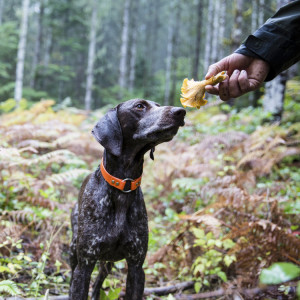The Ultimate Guide to Your New Dog’s Nutrition
From kibble to homemade food, these tips will help you learn the fundamentals of dog nutrition.

Share Article
No matter what you feed your dog, it’s important to understand the fundamentals of their nutrition. There are six major classes of nutrients: protein, fat, carbohydrates, vitamins, minerals, and water. Here is a review of the basics to help you get started in making the right and informed choices for your dog.
It all begins with energy, the basic requirement of life. The energy content (measured in calories) of a food is determined by how much of the first three elements the food contains. Vitamins and minerals are also essential for many body functions, and because about 70 percent of a dog’s body is made up of water, hydration is also critical.
Proteins
Proteins are complex molecules made up of amino acids, the building blocks of cell growth, maintenance, and repair. In our pets, one of the biggest demands for protein comes from the maintenance of fur and hair, which can use up to 30 percent of the daily protein intake, per veterinarian Dr. Barbara Fougère.
Proteins are made up of 20 amino acids. While dogs, cats, and even humans produce about half of these amino acids internally, the other half, termed “essential amino acids,” need to be provided by the diet. The 10 essential amino acids are arginine, histidine, isoleucine, leucine, lysine, methionine, phenylalanine, threonine, tryptophan, and valine. If even one of these “essentials” is deficient, as veterinarian and author Dr. Lowell Ackerman explains, the body cannot make specific proteins effectively. Amino acids work in a step-by-step fashion to manufacture protein.
If one of the steps is missing, the process stops. The biological value of proteins indicates how efficiently an animal utilizes them. Animal nutrition expert Dr. Donald Strombeck notes that this value is high for proteins from meat, most meat by-products, eggs, and dairy products. “Dogs digest these proteins efficiently, and they provide amino acids in proportions suitable for tissue protein synthesis. In contrast, the biological value of most plant proteins is low, due to insufficiencies of specific amino acids and lower digestibility.”
Fats
Fats provide the most concentrated source of energy in the diet. They also supply the fatty acids that are important building blocks for important substances and essential to maintaining normal, healthy cells. Along with protein, fats contribute to a diet’s palatability plus aid absorption of the fat-soluble vitamins A, E, D, and K.
Like protein’s essential amino acids, fat has its own essential fatty acids (EFAs): linoleic acid, linolenic acid and arachidonic acid. Because they make up an important part of every cell, they are also required by animals. Linoleic acid is the source of omega-6 fatty acids, and linolenic acid is the source of omega-3 fatty acids. According to Dr. Strombeck, animals need more omega-6 (linoleic acid) than omega-3 fatty acids for health.
Carbohydrates
Although dogs do not need carbohydrates because their bodies can get energy from protein and fats alone, carbohydrates that can be broken down by the digestive system and converted to glucose can also be a source of energy. (Carbs can be the main caloric source in some dog foods.)
Carbohydrates in the form of whole grains can furnish iron, minerals, and fiber as well as other beneficial nutrients. Since cooking determines starch digestibility and, therefore, its availability, starches need to be well cooked; otherwise, they tend to ferment in the large intestine. Carbohydrates can be found in vegetables and fruit, which also supply minerals, fiber, antioxidants, phytochemicals, and some protein.
Vitamins
Fresh, wholesome food provides your dog (as well as you) with the best source of vitamins and organic substances required for normal functioning of the body. They are also important in the conversion of calories to energy. Dr. Ackerman points out that they are needed in only small amounts: “All of the vitamins needed by your dog on a daily basis could be provided by a fraction of a teaspoon.”
Minerals
Minerals are inorganic nutrients that make up less than one percent of a dog’s body weight but are essential to many important functions, such as growth and strong bones and teeth. They are classified as either macrominerals or microminerals. It is important to note that two of the macrominerals, calcium (the most abundant mineral in the body) and phosphorus, must be in balance and given in correct proportions (the ideal calcium to phosphorus ratio is between 1:1 and 2:1). Micro-minerals (also known as trace minerals) serve very important functions as well. Balance is critical with all minerals because they interact; too much of one can interfere with the absorption of another.
How to choose the best dog food
Here’s what to look for and what to avoid when you’re getting ready to pick your dog’s food.
Look for high-quality meat.
High-quality named animal proteins should be the first ingredient and, ideally, appear more than once as top items on the ingredient list. Note that whole meat is made up of a lot of water (up to 75 percent), so if whole meat is listed as the first item, the food might not contain an equal amount of meat by weight unless there is another whole meat, or a specifically named meat meal (chicken meal, for instance, which is about 10 percent water).
Look for whole foods.
Pick whole fruit, vegetables and whole grains which contain the entire grain kernel—for example, rice rather than rice flour or bran. Refined grain products, gluten, and mill runs should be avoided.
Go for natural preservatives.
Look for natural preservatives like tocopherols (Vitamin E) and Vitamin C, or antioxidants like rosemary extract.
What about dry kibble?
When you compare different types of foods — canned, kibble, etc. or simply different brands — you need to keep in mind the moisture content so you can compare like to like. Use the dry-matter basis.
First, establish the amount of dry matter by subtracting the percentage given for moisture from 100 percent. If the moisture is given as 10 percent, the food’s dry-matter content is 90 percent.
Next, convert the protein found in the “Guaranteed Analysis” statement to a dry matter basis by dividing its percentage by the amount of dry matter (calculated in the previous step). For example, if the protein is given as 26 percent, it converts to 28 percent on a dry-matter basis (26 divided by 90). If the moisture level had been, say, 30 percent, the dry matter content would have been 70 percent and protein would have been 37 percent (26 divided by 70). You can do similar calculations for fat and fiber after converting their percentages to a dry-matter basis.
Consider your dog’s treats.
Although treats are usually given in small portions (or should be!), make sure that you pay the same high level of attention to what’s in them as you do for all of your dog’s food. Look for organic, whole food ingredients, including named meats, whole grains, lots of good fruit and/or vegetables and natural, food-based sweeteners (if they are used at all) — applesauce, honey, or molasses, for example. Look for individual portions that are easy to break into smaller bits.
Treats are often high in calories, so factor them in when thinking about your dog’s overall food intake. It is recommended that “treat substitutes” make up no more than five to 10 percent of a dog’s diet. If the calorie count isn’t listed on the label, find out what it is before giving them to your dog. Contact the manufacturer for calorie information if need be.
To keep bagged treats fresh — and make it a little more difficult for the diligent treat-hound to score — keep the bags sealed. If the seal doesn’t work (often they don’t), use heavy-duty zip lock–type bags or store them in glass or ceramic containers with tight-fitting lids.

Claudia Kawczynska
Claudia Kawczynska was co-founder and editor-in-chief of The Bark for 20 years. She also edited the best-selling anthology Dog Is My Co-Pilot.
Related articles
![brown puppy eating food out of green bowl]()
A Digestible Guide to Healthy Dog Food for Your New Pup
How to pick the right grub for your dog when there are So. Many. Choices.
![Puppy eating a bowl of blueberries]()
10 Superfoods You Should Share With Your New Dog
From kale to quinoa, these nutrient-packed picks deserve a spot in your dog’s food bowl.
![A dog with a toy fish in its mouth]()
Your Dog Will Love This Mackerel Meal Topper
Give your pup their daily dose of omega-3 fatty acids and other crucial nutrients with this fresh, easy-to-make recipe.
![An obese dachshund dog plays with a rubber ball on a sandy beach]()
What to Know When Your Vet Says Your Dog Is Overweight
Don’t take it personally — even if that’s hard to do.








